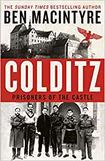
Ben MacIntyre has had a successful and lucrative career as a writer mostly of war stories, predominantly set during the second World War. Operation Mincemeat, the story of the cadaver that helped to divert German forces towards Greece and away from Sicily where the Allies intended to land in 1943, was made into a Hollywood film with an all-star cast last year.
He specialises in excavating the stories that have been overlooked or bringing new perspectives to old stories. Colditz: Prisoners of the Castle is one of the latter. There can hardly be a story from the second World War that has been told as many times as that of Colditz. The feature film, The Colditz Story, was released in 1955, followed by Colditz, the 1972 TV series broadcast on the BBC that attracted a television audience of seven million viewers. Most recently there was Colditz, the TV series, broadcast on Channel 4 in 2005. There has been a proliferation of books and documentaries about this infamous German POW camp.
Those familiar with MacIntyre’s work will recognise many of the attributes that have made him such a successful writer. He tells compelling stories well, with energy and humour. His unerring eye for the telling detail that can illuminate a greater story is apparent in Colditz: Prisoners of the Castle.
Colditz was a place for incorrigible escapees from Allied countries. It was apparent early on that concentrating so many would-be escapees in the same prison camp was probably a mistake. Neither was Colditz the impenetrable fortress of renown. It was a Renaissance castle built on a hill in Saxony. It was so vast that even the German gaolers did not know every tunnel and cellar. At least 32 men escaped and made it across the Swiss border, some 600km away. Dozens more made it out but were apprehended elsewhere.
Conclave: Ralph Fiennes is flawless in Robert Harris’s preposterously gripping drama of papal electioneering
First Look: The Rooftop Bar cocktail and dining area at The Marker – the place to be when the sun sets
The Last of Us drops a bombshell for the TV ages. Did that really just happen?
Let’s put a real kitchen in every school. We could use some of the Apple taxes
The man most responsible for the popular fascination with Colditz is Pat Reid, a past pupil of Clongowes Wood College whose father came from Co Carlow. Reid was captured during the fall of France in 1940.
He escaped Laufen Castle in Bavaria and made a foiled attempt to escape Colditz before making it out in 1942. Reid, according to MacIntyre, once climbed a rugby post to plant a shamrock on the top of it before an England v Ireland international, but spoke in the argot of the Boy’s Own English public schoolboy.
Another name familiar to an Irish audience is Airey Neave. Before he was murdered by the Irish National Liberation Army in 1979, Neave was most famous for having been the first British prisoner to escape from Colditz. He was hugely frustrated when an elaborate ruse to smuggle him out as a German officer was foiled as the counterfeit uniform appeared too green under the searchlight. He escaped in January 1942 and made his way to Switzerland. After returning to Britain he helped co-ordinate the Pat O’Leary line, named after a Belgian, not Irish doctor, which smuggled downed Allied airmen out of occupied Europe.
Colditz’s most famous inmate was RAF pilot Douglas Bader. Bader lost his legs in a flying incident in 1931. It did not deter him from volunteering as a fighter pilot in the second World War in which he excelled before being shot down over France in August 1941. Bader’s disability made escape from Colditz impossible. He was rightly feted for his indomitable courage and was the subject of the 1956 film Reach for the Skies, in which he became the personification of “mustn’t grumble British pluck”.
The Bader that emerges from MacIntyre’s book, however, was a rude, insolent martinet who treated his orderly, a dutiful Scottish man named Alex Ross, abominably.
MacIntyre’s big reveal in this book is that Colditz was far from the egalitarian place of popular renown where distinctions of nationality, class and creed that bedevilled the outside world were forgotten.
In reality the pernicious British class system manifested itself in the extraordinary rule within Colditz that only officers could escape while their orderlies, also known as lackeys, who were mostly privates, had to stay put.
When Ross was chosen for a prisoner exchange in August 1943, Bader would not allow him to leave Colditz. “Look here, Ross, you came here as my lackey and you will stay with me as my lackey until we are both liberated. That’s that,” Bader told him. As a consequence Ross spent another year and nine months in captivity.
The book has an unlikely hero in the Colditz commandant Reinhold Eggers. An Anglophile who had spent time in England, Eggers left his role as a schoolteacher to take a commission in Colditz. Eggers was a decent man who did a difficult job well and remained even-tempered despite the greatest provocations.
In 1943 the mood in Colditz darkened. After an order from Hitler, POWs who escaped and were recaptured were to be executed. Escape attempts from Colditz became a rarity. As the Reich disintegrated, food became scarce and parcels did not get through. MacIntyre’s book makes clear that the liberation of Colditz in April 1945 came not a day too soon for the remaining prisoners and their jailers.
Ronan McGreevy is an Irish Times journalist and the author of Great Hatred: The Assassination of Field Marshal Sir Henry Wilson MP














